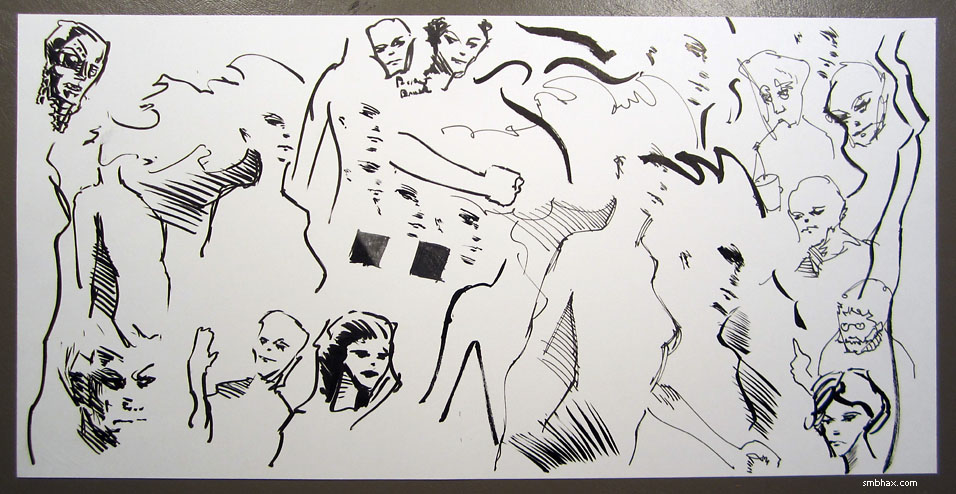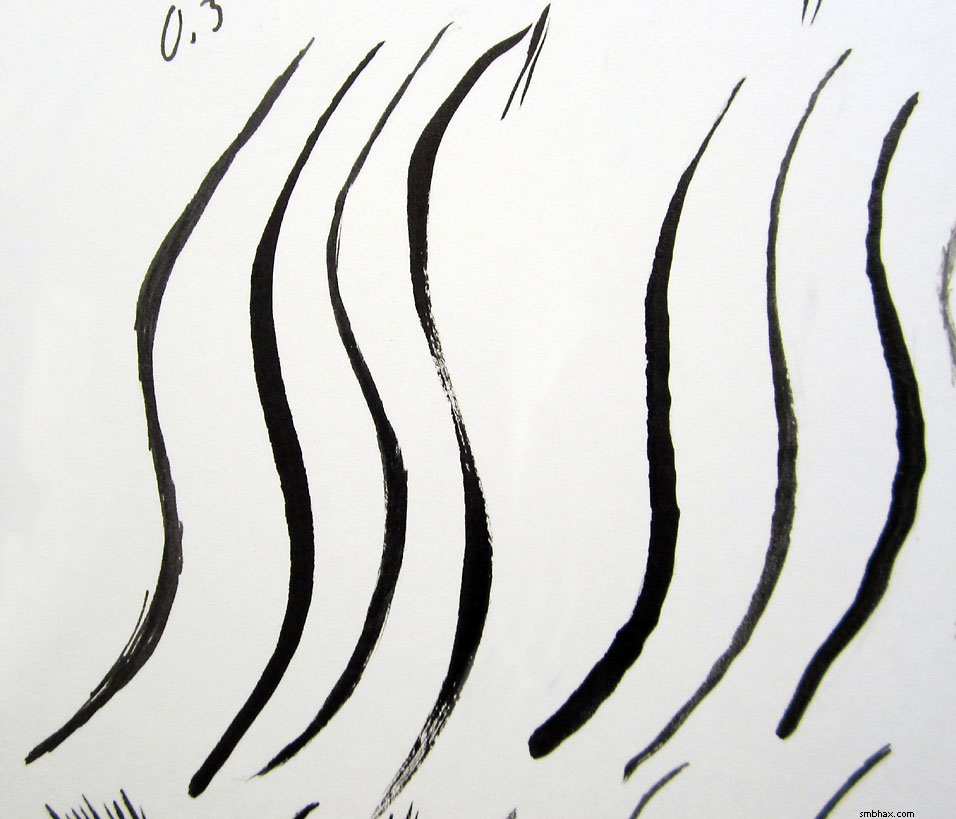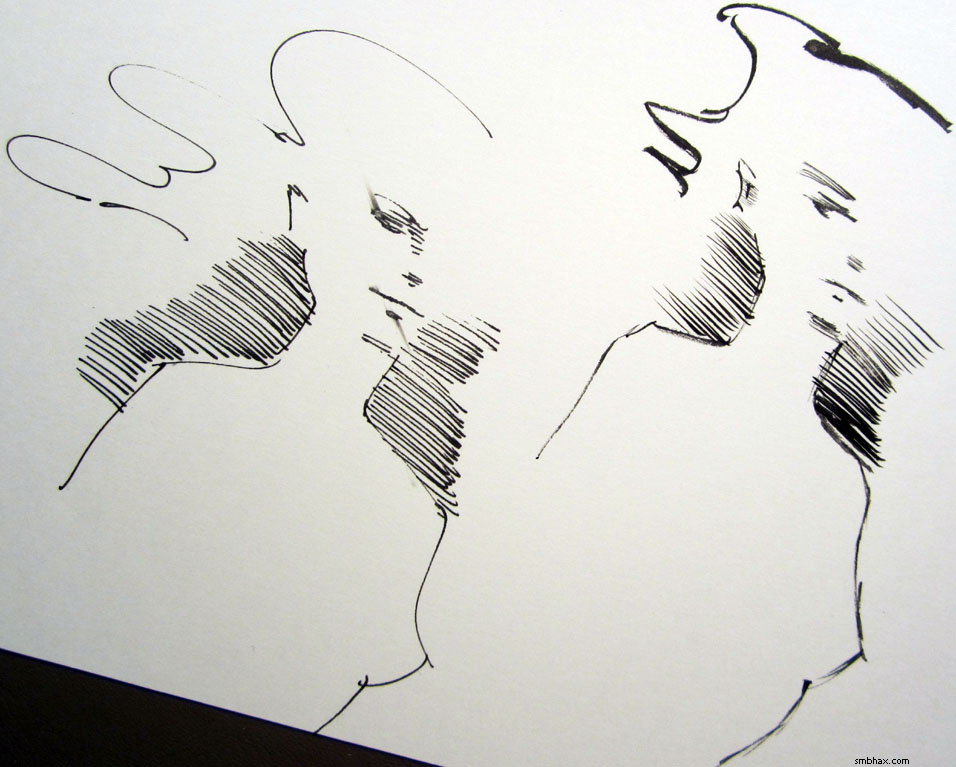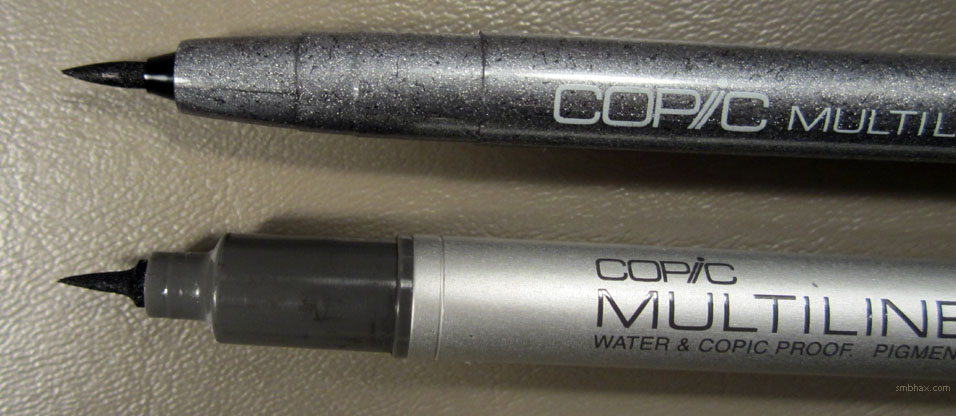 | |
|  |
|
|
| |
| The Pen I am Least Awful at Inking With, Pt 2 | Jun 14, 2014 8:44 AM PDT | url |
| | |
Added 1 new A* page:Man, who knew painting outdoor scenes in watercolor was so fun? : o
Okay about time I finish my bloggy thing about which pen I am least bad at inking with—part one is here, in which I narrowed the field considerably; in fact, I narrowed it down to two pens, my trusty Rotring Tikky Graphic 0.3 technical pen, and the Copic Multiliner SP BS "brush" pen.
So I did a head-to-head with them of sight sketches off of the pencils I need to ink, plus just a bunch of little doodles. It was looking like the SP BS just wasn't quite flexible enough to do the delicate linework I wanted, and anyway it wears down too much under an eraser—so I was going to be trying to ink this piece with the ol' Tikky 0.3, BUT then a twist happened. Namely, a friendly user over at the A* mirror on Drunk Duck commented that they prefer a small brush for this type of work. And as soon as I read that I had to admit to myself that I could certainly get better line quality with a brush, and I'd just kind of been trying to avoid going to a brush because well it's a little more mess and fuss, and more frustrating when things don't quite go right.
Well just to prove things to myself I dug out one of the little "size 0" brushes that were coming free in complementary two-packs with my preferred brush size, 4, of Raphael's 8404 brush; I'd tried one of the 0's once, just to test, but it hadn't been able to carry an unbroken line—but I had a sneaking suspicion that that, along with some of the frustrations that eventually had me abandon even the size 4 brush, was because I was using ink that was just too darn thick. So I diluted the old dregs of ink that have been sitting here unused in my little ink bottle for ages now, adding a surprising amount of water actually without making the ink noticeably less black on paper, but that got it flowing pretty good, and gosh I could do unbroken lines with the little size 0 brush, wouldn't you know. I did these tests—and some with my somewhat used size 4 brush, too—on the same piece of paper on which I had done the final round of pen testing, so it got a little cluttered (you can click this photo for a larger version):

^ Generally, the SP BS was used on the left, the Tikky 0.3 is the thin, fixed-width lines on the right, and the organic lines on the right, including the right-most sight sketch from the pencils, and the doodle in the lower-right corner, were done with the 8404 size 0 brush—except for the slightly heavier-inked Selenis half-faces in the upper right and middle, which were done with the 8404 size 4 (half with the 0 and half with the 4; you have to look pretty closely to see the difference, and to be fair to the 4, in steady hands you shouldn't really see any difference between the two for drawings of that small scale—but I probably *do* have slightly better control with the shorter brush (your hand is closer to the paper when holding it), and also my current size 4 is a little used, so the tip isn't quite perfectly sharp anymore).
Also worth noting are the two black squares in the middle, where I tested the the SP BS, on the left square, and the Tikky 0.3, on the right, against eraser wear by erasing the top right half of each square: while the untouched SP BS ink was darker, running the eraser over it really faded it badly, while the Tikky ink emerged nearly unscathed; as far as I'm concerned, this shows that the SP BS's ink is just unsuitable for pieces where you'd have to use an eraser to clean up underlying pencil lines after doing the inking.
But that was sort of a moot point, because, although, it's a bit hard to tell in looking at that cluttered page now, it was clear pretty immediately as I was drawing that I wasn't going to match this fluid ink brushwork with a pen. Buuut, just to be sure, I did a few more trials. I went back to the test page from part 1 and threw down some long S-curves with the size 0 brush, next to the curve I'd inked (I have to use that term loosely for my attempts here : p) with the Tikky 0.3; in this photo,

in which I've edited out some extraneous older lines, the 0.3 S-curve is on the left, and the rest are 8404 size 0 brush lines that I executed with a single flowing stroke each—well except for the third S-curve, which I think I built up from lots of little size 0 brush strokes; to me, the brush lines are obviously more attractive (and the ink is darker than the pen ink, which doesn't hurt), but you'll notice that the three on the right are slightly wavy or jerky: that's what happened when I was trying to follow an underlying pencil line carefully with the brush, whereas the two single-stroke brush S-curves to their left, which are smoother, I did freehand, not following pencil lines. This is why I'm a bad inker. : P
And finally, a more specific test: sight sketches from the pencils I'm going to be trying to ink, pitting the Tikky 0.3, on the left, directly against the 8404 size 0 brush, on the right:

While I like the smooth quick curves I can do with the pen, in pretty much every other respect, the brush lines, even when they are slightly off, are easier on the eyes than the pen lines—and I still had my ink a little too thick here (I was really surprised by how much I was able to water down this Deleter 3 ink without losing its darkness), so in theory I should be able to execute pretty smooth curves with the brush—although I still tend to bear down a little too much with it on curves, making thicker lines than I might like.
So anyway, if I want this piece I'm going to try to ink to have at least a chance of looking kind of professional, I think I'd better knuckle down and do it with the brush. It will probably take me a while to get into the swing of things with the brush again, and especially doing tight linework, which was never really my thing even back when I using brush and ink on A* every day, and probably never will be...but anyway with practice I should be able to recapture some of the crispness I'll lose initially in going from pen to brush.
Yep, the least awful pen for me to ink with turned out to be a brush, what a shock. : P Back to inky fingers for me! At least on some weekends; hopefully this weekend, for starters, and then I could put the finished piece up for auction Monday evening. If you do like my old black and white brushwork and would like to see me do more of it, well, I hope you'll be checking out the auction, because if I can make a little extra money doing ink pieces, I will definitely have to endeavor to do more of them.
~~~~~~~~
Speaking of inking, it just so happens that today I came across a really good video interview with "Joltin'" Joe Sinnott, an artist who began working in comics in the late Golden Age, 1950, and at age 87 is still going strong today: he inks the Spider-Man Sunday comic strip every week, which you can see on his web site (scroll about halfway down the front page there). Pretty darn amazing! He is most famous for the hundreds of comics, particularly in the boom of Marvel Comics in the early '60s, in which he inked the penciled artwork of Jack Kirby. Anyway in that interview he talks a lot about his tools of the inking trade, which is the type of stuff I'm always very interested to hear; he talks more about them in this other video interview, and that one's in his home office so you get to see his drawing table and work set-up, which is another thing I love to see of other artists.
In both videos, he complains about being unable to find a decent white ink these days; he used to use one called "Poster White," but that has been discontinued; in the slightly older second video, from four years ago, he was using a white ink called "Pro White"; I've tried that one, and really didn't like it. I thought he might like to know about the white ink I use, a Japanese import called "Deleter White 2," which can be ordered directly from Deleter here, or imported through jetpens.com here (more expensive per bottle, but shipping is much faster and cheaper), so I emailed him about it. I don't expect to hear back, but anyway I hope he finds or already has found a good white ink! It took me a while, that's for sure, and I was really glad when I did.
~~~~~~
Oh right I almost forgot (man this is a long one): I'd been meaning to show a close-up comparing the tip of Copic's Multiliner SP BS ("brush small") pen with the tip of the non-SP, disposable Copic Multiliner BS—in this photo it's the regular, disposable Multiliner BS in sparkly grey plastic on the top, and the aluminum-bodied Multiliner SP BS on the bottom:

Really different tips! The more slender and tapering (and replaceable) SP BS nib is much softer and more flexible; I found the regular BS's thicker tip unpleasantly stiff.
~~~~~~
Oh man this is never going to end. Just remembered something about brushes for inking! The Raphael "Kolinsky Sable" brushes, like the 8404, and indeed pretty much all the other Kolinsky hair brushes from other European manufacturers, are currently very hard to come by; you'll notice that on the page at dickblick.com where I usually order mine, almost all of them are on indefinite backorder. : oo Turns out this is due to an import ban on Kolinsky sable hair put in place by the U.S. Fish & Wildlife Service after they noticed that some of the hair put into European-made brushes had been improperly imported from China—illegally, in fact, is what China told them when they checked up on it. So they went and added new paperwork requirements to importing Kolinsky sable hairs, and although all this started last summer, apparently no imported shipments of Kolinsky sable hairs meeting the new paperwork requirements have yet made their way from Chinese Siberia, where the animals have to be raised, through the European brush manufacturers, and thence to our shores. In theory the supply will start to flow once the paperwork gets sorted out all along the line; until then, the good brushes are in shorter and shorter supply! (Waterproof ink in particular really chews through these brushes something fierce: it gets down into the metal ferrule holding the base of the hairs, and starts to spread them apart as it dries in there, essentially ruining the sharp tip the brushes are otherwise able to form; I think I generally got a few dozen A* pages out of a single 8404 size 4 brush before the tip was too separated and I had to go to a new one; watercolor on the other hand, which washes out easily, hardly wears them down at all...and in theory I could make them last longer if I switched to a non-waterproof ink, although those are harder to white-ink over... I've still got a few extra brushes of both size 0 and size 4, but I'll have to switch to weaker ink if the supply chain on these brushes doesn't kick back in eventually!)
The Fish & Wildlife Service, by the way, likes to call the animal these amazingly useful for painting hairs come from the "Kolinsky weasel," undoing decades if not centuries of careful marketing by brush manufacturers attempting to disguise the fact that the animal is not, in fact, a fancy-sounding sable, but is rather a dirty-sounding weasel. Pretty silly! And oh my gosh there is just the cutest weasel photo at the top of Wikipedia's weasel page. (And yes there are even cuter weasel photos out on the internet in droves as I have since found—who knew weasels were so darn photogenic? Well, just me, apparently. : o)
Okay now I am weaseling out and finally going to bed, yay!
|
·····
|
|
|
